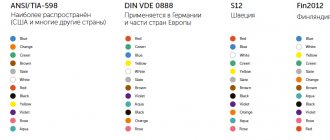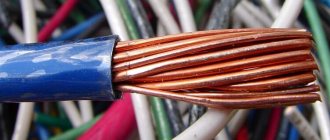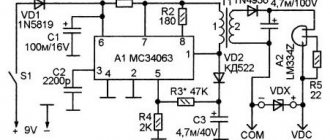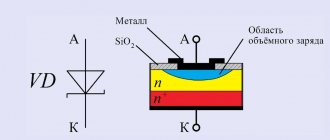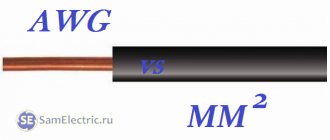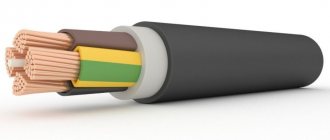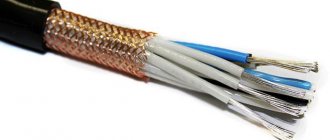Published: 02/5/2012 Category: Electrical Views: 23573
Characteristics of electrical wires
What exactly is meant by the main characteristics of wires?
The main characteristics of any electrical wire are as follows:
- core material
- core section
- number of wires in the core
- insulation material
Now let's look at each characteristic of the wire in as much detail as possible.
Classification of conductors
The types of connecting products used in the installation of an electrical network are given in GOST 15845-80.
Depending on the design and purpose, they are divided into wires, cables and cords.
Wires
They consist of 1-3 copper cores, enclosed in a braid of PVC, polyethylene or rubber. They are united by common isolation. The cores can be solid or consist of several conductors. Their cross-sectional area is no more than 2.5 mm. Wires are not used for laying underground or where increased safety is required.
Cable
Electrical cables have a more complex design and reinforced insulation. There may be additional filling between the cores, sometimes there is a screen, double braiding. To organize electrical wiring in residential premises, only cables are always used. Some of them are laid underground or by air.
Cord
This is a wire with increased flexibility. It is used in devices that must operate in mobile conditions: irons, blenders, electric shavers, etc.
An example is the ShRO cord. Its braid consists of fabric threads, and its flexibility corresponds to class 5.
Most often, such a cord can be seen in household appliances that are subject to movement during operation.
Types of wires
You should choose a suitable wire based on the power of the equipment that will be powered through it. Let's understand what types of wires exist and how they are used in everyday life.
Flat
Flat wires have a rectangular cross-section. Such wires contain one or more cores arranged in one or several layers. Flat wires are divided into several types:
- PBPP (PUNP)
. Single-wire wires that are used to connect sockets or lighting fixtures. The cross-sectional sizes of cores in PUNP wires vary from 1.5 to 6 mm². Flat protected wires PBPP (PUNP) have both external and internal PVC insulation, which allows them to be used at temperatures from −15 to +50 degrees. Such wires bend easily and transmit voltage up to 250 W. - PBPPg (PUGNP)
. According to the main characteristics, PBPPg are no different from PBPP, except for increased flexibility. The letter “g” in the abbreviation indicates precisely the flexibility that is achieved by the presence of stranded conductors. The bending radius is 6 diameters, while in PUNP wires it is 10 diameters. - APUNP
. The wire contains a single-wire aluminum core with a cross-section of 2.5 to 6 mm². All other parameters coincide with PBPP and PBPPg.
Please note that the provisions of the PUE prohibit the use of APUNP wires; their production continues only because of the low price and, as a consequence, high demand. Flat wires should only be used to connect lighting fixtures.
With jumpers
There are two types of jumper wires:
- PPV
. Such wires have 2-3 single-wire cores, and the wire itself is insulated with PVC. Excellent transmission of current with a frequency of up to 400 Hz and voltage of up to 450 W. PVC insulation is resistant to alkalis, acids, low and high temperatures from −50 to +70 ° C, and also withstands 100% humidity conditions. The permissible bending radius is 10 diameters. A distinctive feature of the PPV wire is the characteristic PVC jumper. Core cross-section is 0.75–6 mm². - APPV
. It has the same parameters as PPV, it differs only in the cross-sectional size of the cores - in APPV it is from 2.5 mm². Suitable for lighting and power open wiring.
Single-core
Single-core wires are distinguished by multi-color insulation - with the help of bright colors it is more convenient for electricians to install distribution boards without the use of additional markings. Wires with one core are divided into three types:
- APV
. Aluminum wire with one core (single-wire - 2.5–16 mm²; multi-wire - 25–95 mm²). Thanks to PVC insulation, it can be used in conditions of 100% humidity and can withstand both extremely low and high temperatures (up to +70 °C). Resistant to chemicals. - PV1
. The number in the abbreviation indicates the flexibility class. The wire consists of a single-wire copper core (cross-section 0.75–16 mm²) and multi-wire (cross-section 16–95 mm²). - PV3
. The stranded flexible core as part of the PV3 wire is used when installing lines with multiple bends and transitions.
Purpose of marking wires and cables
The generally accepted color coding system helps to ensure the correct connection of wires during installation and serves the safety of devices and people.
The alphanumeric designation is standardized between all countries. It indicates the technical and design features of the wire and allows you to choose the appropriate option: it indicates the number and material of the cores, the flexibility of the wire, the maximum permissible voltage, and the type of insulating braid.
Main differences
Marking allows you to determine the type of connecting electrical product: wire, cable or cord. For example, the designations of the latter always contain the letter “Ш”. The remaining markings contain information about the design features of the wire and its insulation, and the possibilities of its use.
Advantages and disadvantages
When the functional cores are assembled under a single sheath, such a wire is more convenient to lay, especially in hard-to-reach trays and cable channels. Its shell protects all the cores at the same time, i.e. there is a clear saving in labor costs and in the consumption of insulation material. But there is one scourge of all multi-core wires - this is capillarity, i.e. drawing in moisture from the cut end through the cavities between the insulated conductors. For this purpose, the cavities are filled with rubber or similar non-flammable fillers.
Stranded and single-core cables
Single-core soft copper wires, for example, are widely used in the automotive industry, where the role of the “minus” is played by the car body itself, when distributing electrical wiring in rooms, assembling lighting panels and distribution cabinets, and acoustics.
Single-core copper wires are indispensable in electrical wiring to sockets and lighting fixtures. Every electrician is familiar with the procedure when, in the absence of a standard wire, he is forced to unravel a multi-core cable with a knife, removing individual insulated cores from there to perform the tasks of wiring groups of sockets.
You might be interested in Connecting light bulbs
Important! The insulation and copper conductor of the solid wire must be able to withstand repeated bending when the outlet module is seated in place.
Types of markings
The characteristics of the wires are indicated using colors, letters and numbers. Most often, several types of notation are used. Alphanumeric marking is carried out on the cable braid along the entire length at a set interval, allowing for reliable identification of the wire used.
Color marking helps to carry out competent installation, protecting devices and the electrical network from overheating and short circuits, and people from electric shock.
Insulation layer
The manufacturing material is subject to strict requirements for withstanding voltage, temperatures, UV radiation, and mechanical properties. Most often used:It is no secret that the insulation of copper wires prevents human contact with a potentially dangerous current-carrying circuit. Another role is to prevent short circuits between adjacent phases.
- PVC. It is characterized by low cost, wear resistance, and satisfactory chemical resistance. The downside is the release of harmful gases when overheated.
- Rubber. Characterized by increased flexibility and resistance to negative temperatures.
- Polyethylene. It has excellent dielectric properties, but not as good flexibility as the first two materials.
- Carbolite. A distinctive feature is heat resistance combined with sufficient ductility.
Alphanumeric marking
Cable product designations consist of letters and numbers corresponding to its technical characteristics. Marking is carried out in accordance with GOST 16442-80 and indicates:
- type of product (cable, wire, cord);
- core material;
- braid material of each conductor;
- general insulation material;
- possible presence of armor or screen;
- number of cores;
- cross-sectional area of each conductor;
- permissible voltage limit;
- wire flexibility;
- additional parameters: flammability, smoke and gas formation, degree of toxicity of substances released during combustion and smoldering.
What to look for when choosing a cable
Well, now let's figure out how to choose a cable for electrical wiring? Knowing the structure and labeling, this is not so difficult.
Choosing a cable for wiring
- Let's take the opposite route. Therefore, we immediately sweep away the cables with armor. Working with them is extremely inconvenient, and our wiring cannot be subjected to such mechanical forces as to cause damage. In addition, such a cable is strictly prohibited from being used in wet rooms or outdoors.
- Then we immediately sweep aside cables intended for voltages above 0.66 kV. After all, the voltage in our network is 220 or 380V and there is no point in overpaying for thicker insulation.
VVG cable
- Now regarding the section. For domestic needs, a cable with a cross-section of one core of up to 16 mm2 is usually sufficient, and only for connecting powerful power equipment. In an apartment or house, a cable with a cross-section of 4 mm2 is usually sufficient.
- The number of cores depends on the type of network in which it will be installed. For a three-phase network of 380V we need a five-core cable; for a single-phase network of 220V we need a three-core cable, as in the video.
NUM cable
- Based on all the above conditions, the choice is not that great. The most common cable options are PPG, VVG or NUM, although the latter is more correctly called HYM, since it is made according to German standards and is an analogue of VVG.
Marking of foreign cables
The color marking of cable cores produced abroad is slightly different: the phase wire is brown, the ground wire is black, and the neutral wire is white.
The alphanumeric designation is the same in all countries:
| Product type | View | Designation |
| Cables | power | N |
| agreed type | N | |
| Rated voltage | 300/300 | 0,3 |
| 300/500 | 0,5 | |
| 450/750 | 0,7 | |
| Core material | copper | Cu or absent |
| aluminum | A, Al | |
| Insulation material | Different types of PVC | Y,PV,V |
| Various tires | G, R, N, S | |
| Different types of polyethylene | 2Y, 02Y, 02YS, XLPE, 2X | |
| Semiconducting layer in power cables | semiconducting layer | N |
| Screen | Copper concentric | C, S |
| Made from aluminum foil | A | |
| Water protection | F | |
| Without filler in aluminum shell | FY(2Y), (L}2Y | |
| Outer shell | PVC | V |
| Rubber | R | |
| Polychloroprene | N, Y, PVC | |
| Polyethylene | 2Y | |
| Armor | Flat steel strip | B, S.T.A. |
| Round steel wire | S.W.A. |
Table 3
Insulation material
This is the most important part of the conductors. It is the insulation that gives a cable or wire certain qualities. Conductors can be armored, heat-resistant, waterproof, pressure-proof and others - all this is insulation. Electrical current can be life-threatening and insulating materials are necessary to protect people. However, this is not the only function of insulation. The metal conductor needs protection. This is especially true for multi-core cables.
The cable is usually insulated with TPG, which is placed in a sheath
The main tasks of insulation: protection against leakage and electric shock, mechanical and thermal protection of the cable, indication of conductors. There are a great many types of insulation, as well as the materials from which it is made. There is no point in considering them all. It is enough to describe the types that are used at home, and there are not too many of them. The insulation is divided into TCZ (current-carrying core) and a sheath that covers the outside of the wire.
The main characteristic of the wire insulation material is electrical strength . This is the current value at which the charge penetrates a layer of insulating material 1 mm thick. All cables used in everyday life have multiple electrical strength. A breakdown in such insulation is possible only in case of mechanical damage or due to the long service life of the wire.
The second characteristic of insulation is heat resistance . It's simple: the higher the indicator, the higher the heating temperature the insulation can withstand without losing its qualities. Frost resistance and mechanical strength are added to this indicator. The stronger and more resistant to tearing and bending the insulator material, the better. The term “cable crimping” is associated with the concept of mechanical strength. During manufacturing, when the outer sheath is put on the TPG insulation, the cable is then crimped, acquiring density and structure - flat or round. When purchasing a cable or wire, you must ensure that the conductor is crimped with proper care.
Polyvinyl chloride (PVC) is the most common insulation material. It is a white polymer that is highly resistant to acids and alkalis. Almost non-flammable. The material is quite soft and flexible, however, it has several disadvantages, namely: low frost resistance (up to –20 ° C), although cold-resistant modifications have recently been created; when heated, instead of burning, it begins to emit hydrogen chloride and dioxins (quite harmful substances with caustic smell). For example, when water is added, hydrogen chloride forms hydrochloric acid, that is, when smoke is inhaled, a corrosive acid is formed on the mucous membranes.
PVC insulation
Rubber is an excellent insulator, made from artificial or natural rubbers. Used when increased cable flexibility and frost resistance are required.
Rubber outer sheath of wire
Polyethylene is an insulator with good frost resistance and is very resistant to aggressive substances.
Wire with polyethylene insulating film
Silicone rubber is a very elastic, heat-resistant insulator; when burned, it forms a dielectric protective film.
Impregnated paper has excellent current-insulating qualities, but, unfortunately, it burns well and requires additional materials for thermal insulation.
Carbolite is a plastic material used for the production of socket blocks and cable clamp sheaths, heat-resistant, but brittle.
Wire with carbolite
Information cables usually have a screen It consists of metal foil and functions as a reflector for extraneous electromagnetic signals, as well as equalizing the electric field within itself.
Data cable with screen
Protective cover : High voltage power cables buried in the ground use metal to protect against mechanical stress. There are protective pads under and above the armor. They protect the underlying insulation from the metal of the armor and the latter from external influences.
Armored wire
Wire and cable marking table
The correspondence of the designations to the material of manufacture of cores and insulation is indicated in the table:
| Types of structural elements | Designation | Decoding |
| Veins | A | aluminum |
| No markings | copper | |
| Core insulation | IN | polyvinyl chloride |
| TO | nylon | |
| N, NR | non-flammable rubber | |
| P, Ps, Pv | polyethylene | |
| R | rubber | |
| WITH | fiberglass | |
| ABOUT | polyamide fiber | |
| F | fluoroplastic | |
| E | enamel | |
| G, KG | flexible cable | |
| Top braid | IN | PVC |
| A | aluminum | |
| R | rubber | |
| P, Pu | polyethylene | |
| WITH | lead | |
| G | naked (without braid) | |
| Design Features | G | presence of waterproofing |
| B | armored | |
| E | copper screen |
Table 4
For example, the common VVG 3x1.5 cable means a wire with 3 copper conductors with a cross-section of 1.5 mm² and PVC insulation of each, enclosed in a common polyvinyl chloride braid.
Color indication of wire insulation
This is an important insulation function. All TPGs are enclosed in a sheath of different colors, so you don’t have to guess which core comes out from different sides of the cable. In addition, color marking carries an information load. In different types of cable, the cores have different colors. However, as a rule, in three-core they are white, yellow and red.
Standard color coding for three-core wire
White is taken as a phase, red - zero, yellow or yellow-green - ground wire. With a different scale, the stable binding color is considered to be yellow-green TPG, and other colors, as a rule, are distributed according to the taste of the chain installer. The main thing is to remember or write down which color belongs to what, so as not to make a mistake later.
Standard color coding for five-core cable
Inside the cable itself, under the outer sheath, the insulated conductors are sprinkled with chalk to improve their sliding and prevent the TPG from sticking together.
These articles may also be of interest to you:
- Wire routing
- Wire connection methods
- Selecting a cable for electrical wiring
- What are cables, wires and cords made of?

